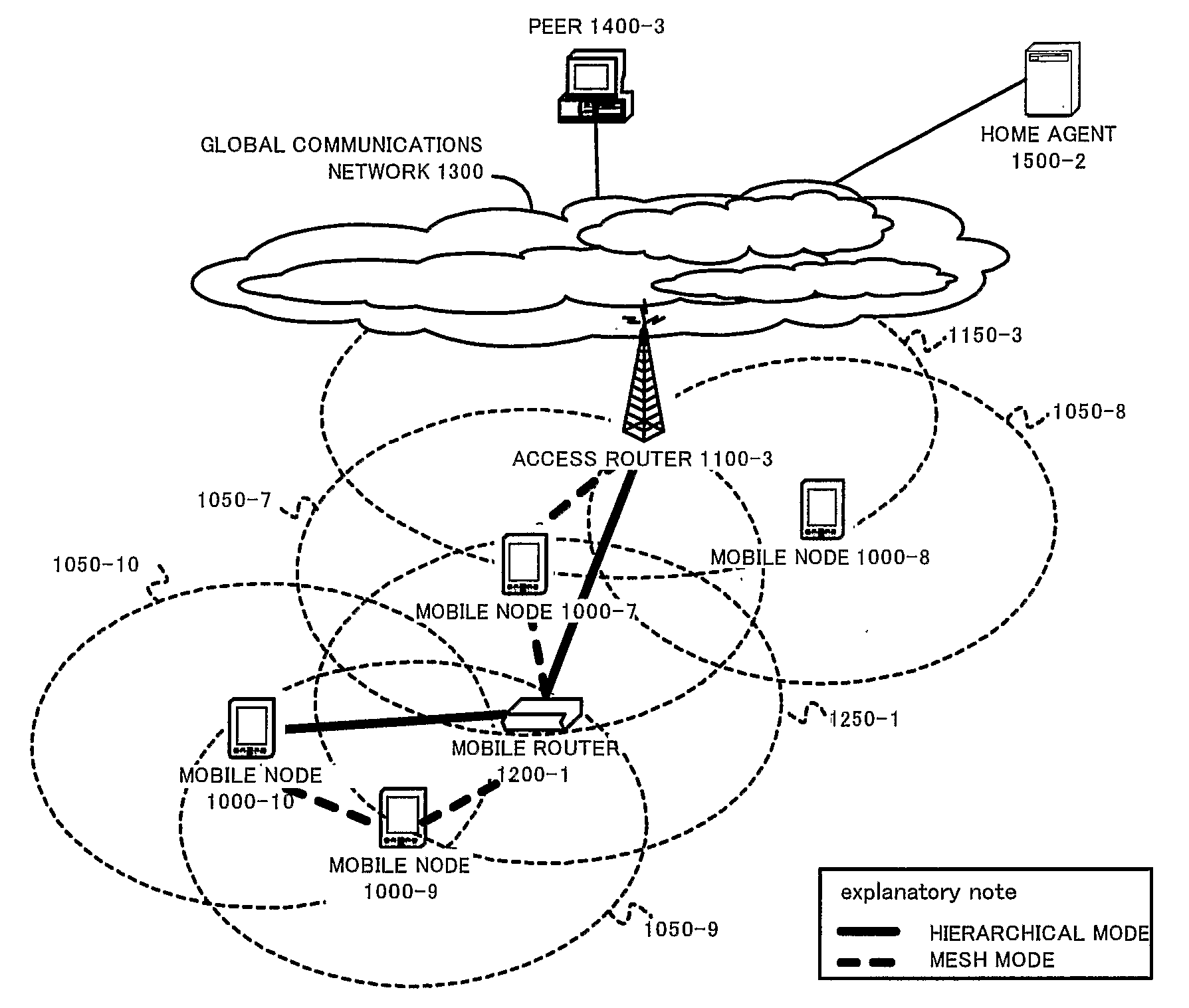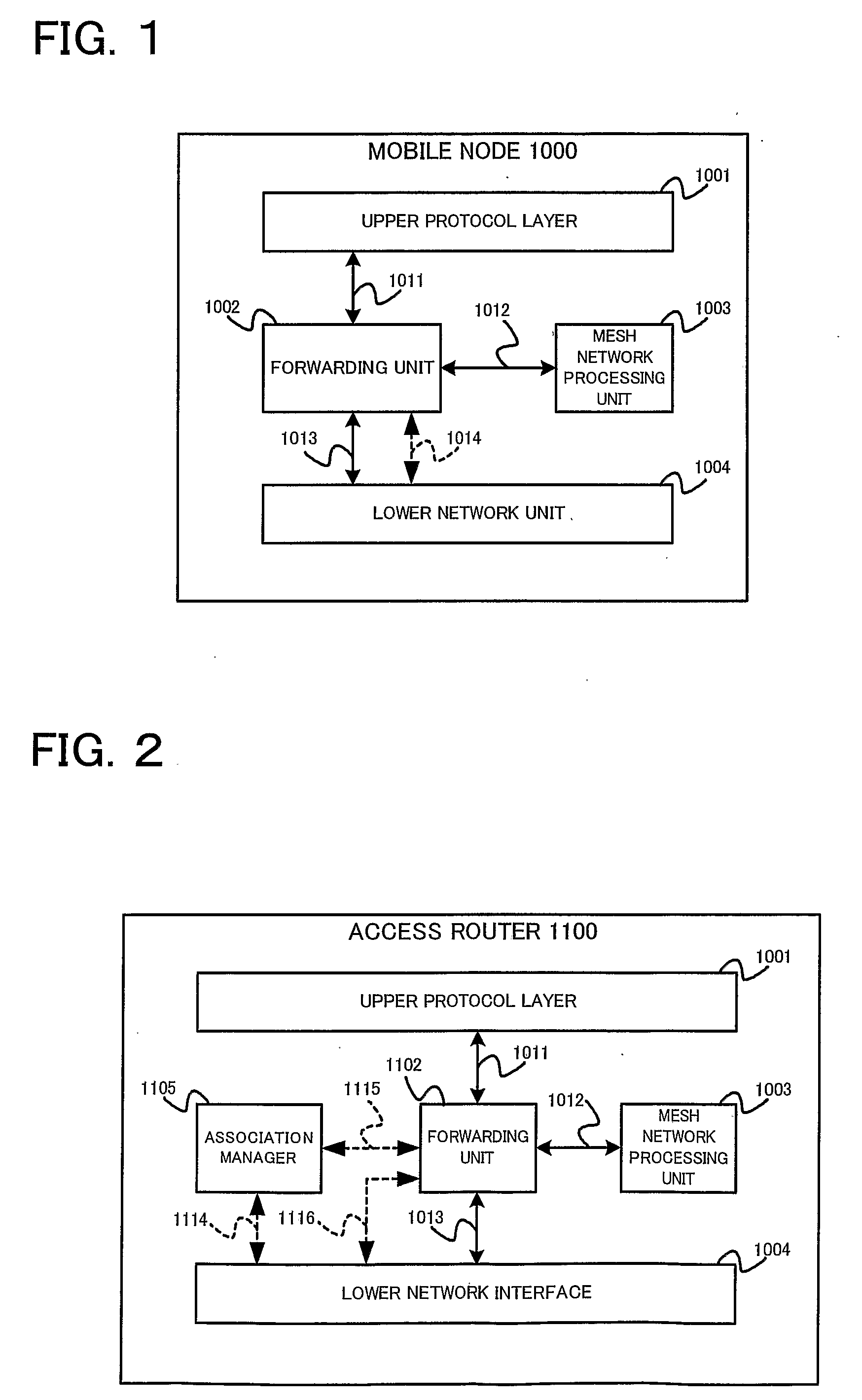Hybrid Mobile Communication System Comprising Multi-Hop-Ad-Hoc and Circuit-Switched Modes
- Summary
- Abstract
- Description
- Claims
- Application Information
AI Technical Summary
Benefits of technology
Problems solved by technology
Method used
Image
Examples
first embodiment
[0072]In the first embodiment of this invention, a mobile node 1000, an access router 1100 and a mobile router 1200 deployed in a general wireless mobile network attached to a global packet-switched data communications network are disclosed. FIGS. 1 to 3 show the architectures of the mobile node 1000, the access router 1100 and the mobile router 1200, respectively. Within these architectures, functional blocks providing identical functionalities are given identical reference numerals. Architecture of the mobile node 1000 comprises an Upper Layer Protocol 1001, a Forwarding Unit 1002, a Mesh Network Processing Unit 1003, and a single or plurality of Lower Network Interface 1004. Architecture of an access router 1100 comprises an Upper Layer Protocol 1001, a Forwarding Unit 1102, a Mesh Network Processing Unit 1003, a single or plurality of Lower Network Interface 1004, and an Association Manager 1105. Architecture of a mobile router 1200 is a hybrid of a mobile node 1000 and an acces...
second embodiment
[0103]In the second embodiment of this invention, a special extension of the above system, apparatuses and methods in the first embodiment are disclosed. In the first embodiment, no assumption is made on the address space partitioning when the mobile nodes use standard Internet Protocols and when the mobile nodes use mesh network protocols. In practical deployments of mobile communications network, it is usually preferable to use distinct address spaces, one for standard Internet Protocols, and one for mesh network protocols. The second embodiment caters for the case when separate address spaces are used.
[0104]In the second embodiment of this invention, a mobile node 2000, an access router 2100 and a mobile router 2200 deployed in a general wireless mobile network attached to a global packet-switched data communications network are disclosed. FIGS. 9 to 11 show the architectures of the mobile node 2000, the access router 2100 and the mobile router 2200, respectively. Within these ar...
third embodiment
[0127]In the third embodiment of this invention, a special extension of the system, apparatuses and methods in the first and second embodiments are disclosed. In the third embodiment, like the second embodiment, the mobile nodes and access routers will encapsulate packets to be forwarded to each other when operating in the mesh mode. However, in the second embodiment, the reason for this extra tunneling is to suit the use of different address spaces. For the third embodiment, the reason is for security reasons: in the mesh mode, other mobile nodes relay packets. Thus, it is vulnerable to spoofing and other related attacks. Hence, it is desirable to encrypt or at least protect the integrity of packets when communicating in the mesh mode. The easiest way to do so is to encapsulate the packet into an encrypted or security protected tunnel between the mobile node and its access router. Although in the second embodiment and the third embodiment, packets are encapsulated in the mesh mode ...
PUM
 Login to View More
Login to View More Abstract
Description
Claims
Application Information
 Login to View More
Login to View More - R&D
- Intellectual Property
- Life Sciences
- Materials
- Tech Scout
- Unparalleled Data Quality
- Higher Quality Content
- 60% Fewer Hallucinations
Browse by: Latest US Patents, China's latest patents, Technical Efficacy Thesaurus, Application Domain, Technology Topic, Popular Technical Reports.
© 2025 PatSnap. All rights reserved.Legal|Privacy policy|Modern Slavery Act Transparency Statement|Sitemap|About US| Contact US: help@patsnap.com



